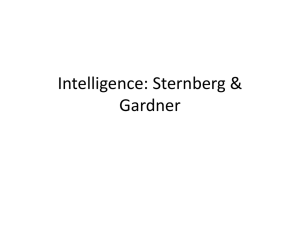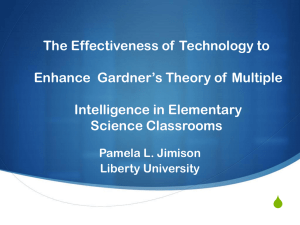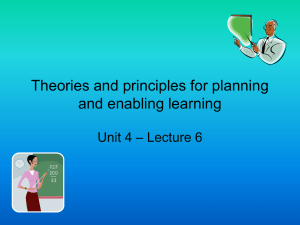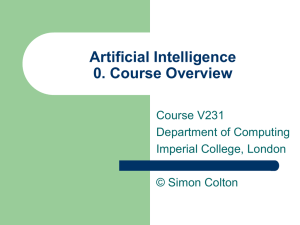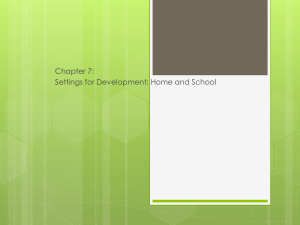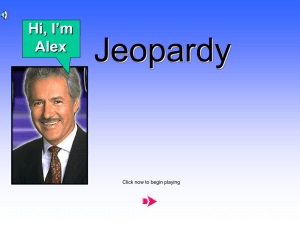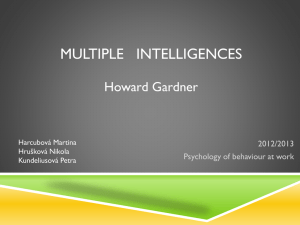Intelligence and taxonomy
advertisement
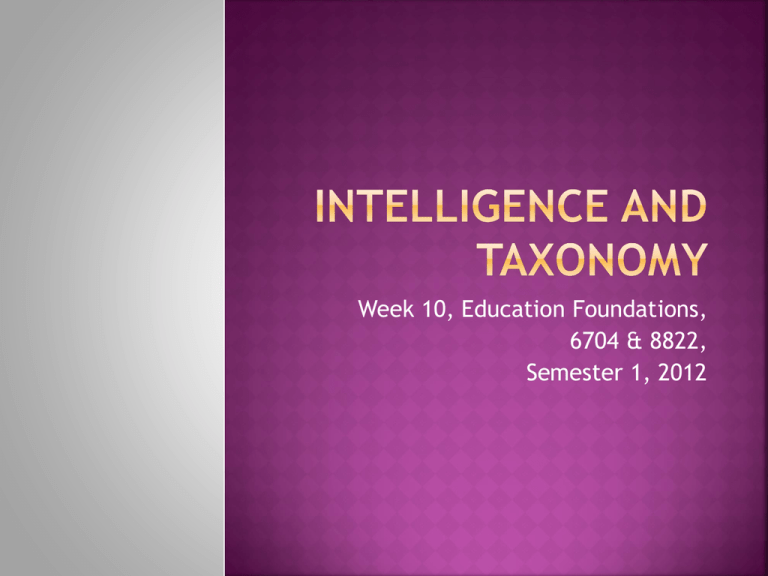
Week 10, Education Foundations, 6704 & 8822, Semester 1, 2012 Module 4: Teaching ALL students Intelligence • What is it • History of testing • Current models (Gardner & Sternberg) Bloom’s Taxonomy Teaching exceptional students ‘Stop-think-write’: Think about a person you think is intelligent. Write down a name and the first 4 or 5 words that come to mind when you think of that person. What made you pick this person? [Latin] ‘intelligere’: to understand ‘inter-’: between; ‘legere’: to choose, pick out, read’ (etymonline.com) Francis Galton: Intelligence as heredity • ‘Synaptic efficiency’ and reaction time • Arthur Jensen (2002) • Mike Anderson (1992) Sir Francis Galton (1822-1911) Intelligence as heredity Alfred Binet: Father of the first intelligence test • Galton’s contemporary • Social background • Intelligence: ability to adapt, comprehend and reason. • Intelligence test as objective evaluation • Binet-Simon Intelligence Scale (1905) • Sample and age norms Alfred Binet (1857-1911) Lewis Terman: Intelligent Quotient (IQ) • Social background • Revision of Binet-Simon Scale IQ mentalage 100 chrono log icalage Lewis Terman (1877-1956) Charles Spearman: the g factor • Correlation between performances in various tests • A two-factor theory of intelligence: a) General ability (g) b) Special abilities Charles Spearman (1863-1945) David Wechsler: Non-verbal intelligence test • The problem of overreliance on language • Culture-fair tests David Wechsler (1896-1981) To find out more about nonverbal IQ tests, try http://www.raventest.net/ Howard Gardner “An intelligence is the ability to solve problems, or to create products, that are valued within one or more cultural settings” (Gardner, 1983/2003, p. x) “An intelligence is a biological and psychological potential; that potential is capable of being realized to a greater or lesser extent as a consequence of the experiential, cultural, and motivational factors that affect a person” Linguistic Logical-mathematical Musical Spatial Bodily-kinaesthetic Personal: inter Personal: intra Naturalist Existential ? Seven kinds of intelligence would allow seven ways to teach, rather than one. And powerful constraints that exist in the mind can be mobilized to introduce a particular concept (or whole system of thinking) in a way that children are most likely to learn it and least likely to distort it. Paradoxically, constraints can be suggestive and ultimately freeing. (Gardner, 1993, p.xxiii) Correlation between different abilities suggests the existence of the g factor Intelligences or talents Multiple representations of concepts An example: mathematics 1. Symbolic/numeric: 2. Descriptive, written: 3. Pictorial: Translations 2 1 1 x1 2 2 1 2 2 groups of are transformations Mendieta, G. (n.d.) Pictorial Mathematics 1 1 2 Diverse learning activities Individual profiling and authentic assessment Myths • • • of MI 7 intelligences = 7 ways of teaching Superficial inclusion of activities Decontextualised evaluation of intelligences Robert J. Sternberg ‘skills and knowledge needed for success in life, according to one’s own definition of success, within one’s own sociocultural context (Sternberg, 2004, p.326; cited in Woolfolk & Margetts, 2010, p.138). Teaching analytically Critique Teaching creatively Invent Teaching practically Use Judge Discover Compare / contrast Evaluate Assess Imagine if… Put into practice Implement Suppose that … Predict Employ Render practical Nature or nurture? One or many? The Cognitive Process Dimension The KnowRemem Undersledge Apply Analyze Evaluate Create ber tand Dimension Factual Knowledge List Summarize Classify Order Rank Combine Conceptual Knowledge Describe Interpret Experiment Explain Assess Plan Procedural Knowledge Tabulate Predict Calculate Differen tiate Conclude Compose MetaCognitive Knowledge Approp riate Execute Use Construct Achieve Action Actualize Disability in Australia: ABS data Impairment, disorder, disability, and handicap Who are exceptional students? The issue of labelling Person-first language Different support needs: • Low severity-high incidence • High severity-low incidence Special education programs and resources • IEP Teachers’ perspective Parents’ perspective Students’ perspective Continuing debate Social inclusion Effective teaching strategies Friendships Working with teaching assistants Planning, organisation and collaboration Contributing to whole-school cultural change Australian Bureau of Statistics (2009) http://www.abs.gov.au/ausstats/abs@.nsf/Latestproducts /4446.0Main%20Features42009?opendocument&tabname=S ummary&prodno=4446.0&issue=2009&num=&view= Anderson, M. (1992) Intelligence and Development: A Cognitive Theory, Blackwell, Oxford. Gardner, H. (1983/2003) Frames of Mind: The Theory of Multiple Intelligences. New York: Basic Books. Grigorenko, E. (n.d.) Triarchi Theory of Intelligence. http://www.education.com/reference/article/triarchictheory-of-intelligence/. Accessed March, 2012. Jensen, A. R. (2002). Galton's legacy to research on intelligence. Journal of Biosocial Science, 34, 145-172. Mendieta, G. (n.d.) Pictorial Mathematics, www.pictorialmath.com, accessed June, 2010. Sternberg, R. J. (n.d.) Successful Intelligence in the Classroom. http://www.lincolnparkboe.org/pdf/Sternberg_on_intellig ences.pdf. Accessed March, 2012.
